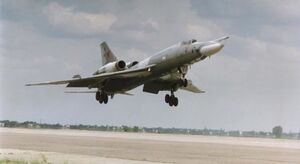AFSB-1 Vespa Supersonic Bomber: Difference between revisions
mNo edit summary |
mNo edit summary |
||
| (One intermediate revision by the same user not shown) | |||
| Line 3: | Line 3: | ||
|name = Vulcan AFSB-1 Vespa | |name = Vulcan AFSB-1 Vespa | ||
|image = Image:AFSB1Vespa.jpg | |image = Image:AFSB1Vespa.jpg | ||
|caption = An AFSB-1 landing in Cacerta 1965. | |caption = An AFSB-1 landing in Cacerta in 1965. | ||
}}{{Infobox aircraft type | }}{{Infobox aircraft type | ||
|type = {{wpl|Supersonic aircraft|Supersonic}} {{wpl|bomber}} | |type = {{wpl|Supersonic aircraft|Supersonic}} {{wpl|bomber}} | ||
| Line 75: | Line 75: | ||
[[Category:Cacerta]] | [[Category:Cacerta]] | ||
[[Category:Cacertian Aircraft]] | |||
[[Category:Military of Cacerta]] | [[Category:Military of Cacerta]] | ||
[[Category:Cacertian Royal Air Fleet]] | [[Category:Cacertian Royal Air Fleet]] | ||
Latest revision as of 18:45, 30 April 2021
This article is incomplete because it is pending further input from participants, or it is a work-in-progress by one author. Please comment on this article's talk page to share your input, comments and questions. Note: To contribute to this article, you may need to seek help from the author(s) of this page. |
| Vulcan AFSB-1 Vespa | |
|---|---|

| |
| An AFSB-1 landing in Cacerta in 1965. | |
| Role | Supersonic bomber |
| National origin | |
| Manufacturer | Vulcan Aeronautics |
| First flight | 11 November 1959 |
| Introduction | 5 May 1961 |
| Retired | 14 June 1972 |
| Primary user | |
| Produced | 1960—1965 |
| Number built | 43 |
The Vulcan AFSB-1 Vespa (Wasp) was the first supersonic bomber to enter production in Cacerta and one of the first aircraft of its class in Tyran. The Vespa was designed and manufactured by Vulcan Aeronautics and entered service with the Cacertian Royal Air Fleet in 1961. Produced in small numbers, the Vespa was eventually retired in 1972 after eleven years in active duty.
Despite being considered a technological step forward, the Vespa is generally considered to be a failure. It lacked the intercontinental range that had been originally intended, thereby relegating the Vespa to short-range missions. At the end of its service life, Vespas were used as test platforms for Cacertian standoff missiles and as supersonic reconnaissance aircraft. The entire fleet was retired in favor of the technologically superior AFSB-2 Spettro strategic bombers.
As of 2019, only a single example of the Vespa exists at the Cacertian Aerospace Museum.
Development
Design
Operation History
Variants
Operators
Former Operators
 Cacerta; Cacertian Royal Air Fleet—The CRAF operated the Vespa between 1961 and 1972. Their entire fleet of AFSB-1s were eventually replaced by the AFSB-2.
Cacerta; Cacertian Royal Air Fleet—The CRAF operated the Vespa between 1961 and 1972. Their entire fleet of AFSB-1s were eventually replaced by the AFSB-2.
Specifications
General Characteristics
- Crew: 3 (pilot, navigator, weapons officer)
- Length: 41.6 m (136 ft 6 in)
- Wingspan: 23.17 m (76 ft)
- Height: 10.13 m (33 ft 3 in)
- Wing Area: 162 m² (1,740 ft²)
- Gross Weight: 85,000 kg (187,393 lbs)
- Max Takeoff Weight: 92,000 kg (202,825 lbs)
- Powerplant: 2 × VulAer Sup-1 Afterburning Turbojets
Performance
- Maximum Speed: Mach 1.42 (1,510 km/h, 940 mph) at altitude
- Range: 4,900 km (3,000 mi, 2,600 nmi)
- Service Ceiling: 13,300 m (43,600 ft)
- Rate of Climb: 12.7 m/s (2,500 ft/min)
- Wing Loading: 525 kg/m² (108 lb/ft²)
- Thrust/Weight: 0.39
Armament
- Guns: 1 × 23 mm cannon in tail turret
- Payload: 24,000 kg (53,000 lb) across wing and fuselage pylons and internal weapons bay
